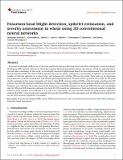| dc.contributor.author | Hamila, Oumaima | |
| dc.contributor.author | Henry, Christopher J. | |
| dc.contributor.author | Molina, Oscar I. | |
| dc.contributor.author | Bidinosti, Christopher P. | |
| dc.contributor.author | Henriquez, Maria Antonia | |
| dc.date.accessioned | 2024-05-07T20:19:15Z | |
| dc.date.available | 2024-05-07T20:19:15Z | |
| dc.date.issued | 2024-04-10 | |
| dc.identifier.citation | Hamila, Oumaima, Christopher J. Henry, Oscar I. Molina, Christopher P. Bidinosti, and Maria Antonia Henriquez. "Fusarium head blight detection, spikelet estimation, and severity assessment in wheat using 3D convolutional neural networks." Canadian Journal of Plant Science, e-First, 10 April 2024. DOI: 10.1139/cjps-2023-0127. | en_US |
| dc.identifier.issn | 0008-4220 | |
| dc.identifier.uri | https://hdl.handle.net/10680/2135 | |
| dc.description.abstract | Fusarium head blight (FHB) is one of the most significant diseases affecting wheat and other small-grain cereals worldwide. Developing FHB-resistant cultivars is critical but requires field and greenhouse disease assessment, which are typically laborious and time consuming. In this work, we developed automated applications based on three-dimensional (3D) convolutional neural networks (CNNs) that detect FHB symptoms expressed in wheat, estimate the total number of spikelets versus the total number of infected spikelets on a wheat head, and subsequently calculate FHB severity index. Such tools are an important step toward the creation of automated and efficient phenotyping methods. The data used to generate the results are 3D point clouds consisting of four colour channels——red, green, blue (RGB), and near-infrared (NIR)——collected using a multispectral 3D scanner. Our 3D CNN models for FHB detection achieved 100% accuracy. The influence of the multispectral information on performance was evaluated; the results showed the dominance of the RGB channels over both the NIR (720 nm peak wavelength) and the NIR plus RGB channels combined. Our best 3D CNN models for estimation of total and infected number of spikelets achieved mean absolute errors (MAEs) of 1.13 and 1.56, respectively. Our best 3D CNN models for FHB severity estimation achieved 8.6 MAE. A linear regression analysis between the visual FHB severity assessment and the FHB severity predicted by our 3D CNN showed a significant correlation. | en_US |
| dc.description.sponsorship | This research was funded by Mitacs (Accelerate IT25876), Western Economic Diversification Canada (Project No. 15453), and Agriculture and Agri-Food Canada. | en_US |
| dc.description.uri | https://doi.org/10.1139/cjps-2023-0127 | en_US |
| dc.language.iso | en | en_US |
| dc.publisher | Canadian Science Publishing | en_US |
| dc.rights | info:eu-repo/semantics/openAccess | en_US |
| dc.subject | Fusarium head blight (FHB) | en_US |
| dc.subject | Wheat | en_US |
| dc.subject | FHB severity detection | en_US |
| dc.subject | 3D convolutional neural network (3D CNN) | en_US |
| dc.subject | Multispectral point cloud | en_US |
| dc.subject | Assessment | en_US |
| dc.title | Fusarium head blight detection, spikelet estimation, and severity assessment in wheat using 3D convolutional neural networks | en_US |
| dc.type | Article | en_US |
| dc.identifier.doi | 10.1139/cjps-2023-0127 | en_US |

